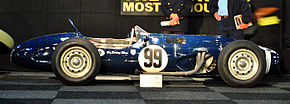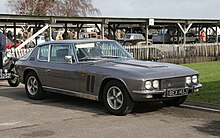Ferguson Research
The Ferguson Research Ltd. was a company from England , founded by Sir Harry Ferguson and racing driver and technician Tony Rolt , best known for its innovative all-wheel drive and as a manufacturer of an all-wheel drive Formula 1 racing car .
Harry Ferguson was originally involved in the Massey Ferguson company, which was already a global manufacturer of tractors at that time . In 1950, however, he decided to leave this company, sell his shares and use the proceeds to buy Ferguson Research Ltd. to found. There he devoted himself primarily to the development of racing car components until he suddenly died in 1960. After Ferguson Research closed, Tony Rolt founded the successor company FF Developments in 1971 with the consent of Ferguson's family , which he sold himself in 1994.
formula 1
In 1960 the Ferguson Project 99 or P99 was built, a four-wheel-drive Formula 1 vehicle in which a 4-cylinder engine from Coventry Climax with a displacement of 1.5 l did its job. After Ferguson's death in October 1960, the vehicle was used only a few months later under Jack Fairman and Stirling Moss at the British Grand Prix in Aintree in 1961. However, only one race outside of the Formula 1 World Championship was won - the rainy Oulton Park Gold Cup Race by Stirling Moss. This is still the only victory of a four-wheel-drive Formula 1 vehicle to this day. The car was too prone to failure, and only a short time later the “outdated” concept of the front engine was replaced by vehicles with a mid-engine. Still, in 1997, Stirling Moss named the P99 in the September issue of MotorSport as his favorite Formula 1 car.
Ferguson Research later supplied other racing teams with their four-wheel drive: BRM , Matra , Lotus and McLaren . In 1969, up to four vehicles competed in Formula 1 races using the Ferguson system. Nevertheless, the all-wheel drive concept was not successful and was replaced by the aerodynamic wings that were also developed in 1969. The last attempt to use all-wheel drive technology in Formula 1 was made by Lotus in 1971 with the turbine-driven 56B , which also used Ferguson technology.
All-wheel drive has been banned in Formula 1 since 1983.
Rallycross
Apart from the above-mentioned Formula 1 teams, Ford also dealt with Ferguson's all-wheel drive technology. Between spring 1969 and autumn 1971, the plant used two Ford Capri 3000GT 4WDs under the two brothers Roger Clark and Stan Clark in the then still young auto sport rallycross and also supported Rod Chapman's largely identical semi-works car. After many teething troubles, the all-wheel-drive Capris became more and more successful, were often only allowed to drive five or ten seconds (4WD penalty) behind the two-wheel-drive competitors and still won almost all of their races by the end of 1970 at the latest. While Ford itself produced the "beasts" (with a Zodiac V6 engine, 3-liter displacement, CanAm gasoline injection, ZF transmission, etc.), which ended up with over 250 hp , before the start of the British winter rallycross series in 1971 / 72 mothballed, Chapman was still active for around a year longer with his 4 × 4 Capri. Since 1973 in Rallycross after FIA - Regulations was driven, disappeared in late 1972 the first generation of four-wheel vehicles for getting out of this just burgeoning motor sport discipline.
Road vehicles
The most famous road vehicle that used an all-wheel drive developed by Ferguson Research was the Jensen FF, built from 1966 to 1971 . It was the world's first series-production passenger car (320 units produced) with all-wheel drive - and not, as is often assumed, the Audi quattro .
In 1968, Ford built a 22-spec series of the Ford Zephyr with Ferguson technology for the British police on behalf of the Home Office . 20 of them were reported as executive vehicles with police -Schriftzügen and blue light into service and referred by their users as "extraordinary" and praised. However, no more cars were ordered after that, because the conversion costs turned out to be too high for the police and they soon decided to buy the new Range Rover .
In addition, Ferguson equipped a number of other vehicles with all-wheel drive at the customer's request. These included the Austin 1800 (one vehicle), Ford Capri (17 units), the Ford Mustang (three units), the Opel Admiral (17 units) , the Reliant Scimitar (one unit), the Triumph Stag and the Triumph 2.5 PI (each two vehicles).
literature
- Mike Taylor: Best feet four-ward. Biography of Harry Ferguson in: Classic & Sports Car, issue 6/2012, p. 138 ff.
Web links
Individual evidence
- ↑ Overview in: Classic & Sports Car issue 6/2012, p. 143.

